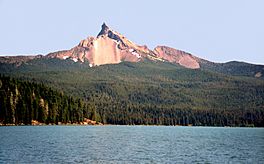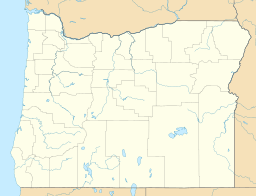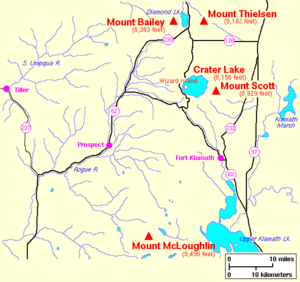Diamond Lake (Oregon) facts for kids
Quick facts for kids Diamond Lake |
|
|---|---|

Lake with Mount Thielsen in the background
|
|
| Location | Douglas County, Oregon |
| Coordinates | 43°09′31″N 122°09′03″W / 43.15861°N 122.15083°W |
| Type | natural, eutrophic |
| Primary inflows | Silent Creek, Short Creek |
| Primary outflows | Lake Creek |
| Catchment area | 55 square miles (140 km2) |
| Basin countries | United States |
| Max. length | 3.5 mi (5.6 km) |
| Max. width | 1.5 mi (2.4 km) |
| Surface area | 3,040 acres (12.3 km2) |
| Average depth | 24 ft (7.3 m) |
| Max. depth | 52.5 ft (16.0 m) |
| Water volume | 77,100 acre-feet (95,100,000 m3) |
| Residence time | 1.6 years |
| Shore length1 | 11 mi (18 km) |
| Surface elevation | 5,183 ft (1,580 m) |
| 1 Shore length is not a well-defined measure. | |
Diamond Lake is a beautiful natural lake in the southern part of Oregon, a state in the United States. It is found in Douglas County, within the Umpqua National Forest. The lake sits between two mountains: Mount Bailey to the west and Mount Thielsen to the east. It is also just north of the famous Crater Lake National Park.
Water flows out of the north end of Diamond Lake into Lake Creek. This creek then joins the North Umpqua River, and eventually, the water reaches the Pacific Ocean.
Diamond Lake got its name from John Diamond. He was a pioneer settler from Coburg, Oregon. In 1852, he saw the lake while standing on top of Diamond Peak, which is also named after him. John Diamond was part of a group trying to create a new road for people to travel between the Middle Fork Willamette River and Idaho.
There used to be a post office called Diamond Lake, Oregon, near the lake. It opened in 1925 and operated until 1956. After that, it only opened during the summer months.
Diamond Lake has hosted big fishing events, like the Major League Fishing Championship in 2019 and 2020. It also hosts the Tour de Diamond, a cycling event that happens every summer. This cycling race is known as the longest one in the World Cycling Association.
Contents
Fish and Wildlife: What Lives in Diamond Lake?
Diamond Lake is a great home for fish, even though rainbow trout are not naturally from here. The lake has lots of aquatic insects, which are perfect food for fish.
Bringing Trout to Diamond Lake
In 1954, the Oregon Department of Fish and Wildlife (ODFW) worked to remove unwanted fish from the lake. After that, they put a special type of rainbow trout from Canada into the lake. Around 1970, they added local types of trout too.
These trout grew very quickly in the lake. For a while, people fishing there would often catch large rainbow trout, some weighing as much as 10-pound (4.5 kg). The average fish caught was usually more than 1 pound (0.45 kg).
Dealing with Unwanted Fish Species
However, in 1992, a new fish called the tui chub appeared in the lake. These fish were not supposed to be there and were introduced illegally. They multiplied very fast and caused problems for the trout and other wildlife. The lake water became cloudy, and the number of insects dropped a lot. This led to a decrease in the trout population.
To fix this, the ODFW used a special treatment called rotenone in 2006. This treatment helped remove the tui chub. About 95 million tui chub were removed, and the lake became free of them. By 2007, the water was much clearer, insect populations grew back, and people started catching more trout again.
The ODFW also found another unwanted fish called golden shiners, which were also illegally put into the lake. Even though shiners don't multiply as fast as tui chubs, the ODFW continues to work on removing them. They also try to stop people from adding more unwanted fish to the lake.
In 2016, a single tui chub was found in the lake again. To prevent another big problem, Oregon planned to release up to 25,000 fish-eating tiger trout into the lake. Scientists were not sure how this one tui chub got there, as it was four years old and would have been alive during the 2006 removal.
Fun Activities at Diamond Lake
Diamond Lake is a popular spot for many outdoor activities throughout the year.
Fishing and Boating
People who love to fish often go by boat near Silent Creek on the south side or in the deeper water on the north side. There are five boat ramps around the lake, all with paved access for easy use. To keep everyone safe, the speed limit for boats on the lake is 10 miles per hour (16 km/h).
You can also fish from the shore at different spots along the lake trails. Good places include near the Diamond Lake Resort, close to Lake Creek, and by the United States Forest Service campgrounds. Fishing is usually open from late April until late October.
Hiking and Biking Trails
There are trails that connect Diamond Lake to the tops of Mount Bailey and Mount Thielsen. The famous Pacific Crest Trail and Crater Lake are also close by. One of the trails around the lake is an 11 miles (18 km) long bike path, and part of it is paved. Many people enjoy watching wildlife and birdwatching in this area. The Joseph H. Stewart State Recreation Area is the closest state park to Diamond Lake.
Camping and Picnics
The Forest Service manages four campgrounds near Diamond Lake.
- Diamond Lake Campground: This is the largest, with 240 campsites along the east side of the lake.
- Broken Arrow Campground: It has 148 sites at the south end of the lake.
- Thielsen View Campground: This campground offers 58 sites along the west shore.
- South Shore Area: This smaller area has five campsites.
These campgrounds offer picnic tables, restrooms, showers, and garbage bins. Some even have hookups for recreational vehicles. The South Shore Picnic Area also has a playground, a volleyball court, horseshoe pits, and a swimming beach, in addition to picnic spots.
Other Fun Activities
In the summer and fall, people enjoy swimming, horseback riding, and hunting at Diamond Lake. When winter arrives, the lake area becomes a hub for snow sports. These include snowmobiling, Nordic (cross-country) and Alpine (downhill) skiing, inner tubing, and even sled dog racing.
The Diamond Lake Resort, located on the east side of the lake, provides places to stay, restaurants, stores, and rentals for boats and horses, along with other services.




